LoRaWAN™ What is it?
A technical overview of LoRa® and LoRaWAN
Introduction
This document aims to provide an introductory technical overview of LoRa® and LoRaWAN™. Low-Power Wide-Area Networks (LPWAN: Low–Power, Wide-Area Networks) are expected to support a significant portion of the billions of devices anticipated in the Internet of Things (IoT) space. LoRaWAN™ is designed from the ground up to optimize low-power wide-area networks in terms of battery life, capacity, coverage, and cost. This document will summarize the LoRaWAN™ specifications across different regions and provide a macro-level comparison of various competing technologies in the low-power wide-area network domain.
What is LoRa®?
LoRa® is a physical layer or wireless modulation technology used to create long-range communication links. Many traditional wireless systems use Frequency Shift Keying (FSK) modulation as the physical layer because it is an efficient modulation method for achieving low power consumption. LoRa® is based on Chirp Spread Spectrum (CSS), which retains the low power characteristics of FSK modulation while significantly increasing communication range. Due to its ability to achieve long-distance communication and strong anti-interference capabilities, Chirp Spread Spectrum technology has been used in military and space communications for decades, and LoRa® is the first low-cost implementation for commercial use.
Long Range (LoRa®)
The core advantage of LoRa® lies in its exceptional long-range communication capabilities. A single gateway or base station can cover an entire city or hundreds of square kilometers. The communication range largely depends on the environmental conditions or obstacles at specific locations, but the link budget of LoRa® and LoRaWAN™ is higher than any other standardized communication technology. The link budget is typically measured in decibels (dB) and is a key factor in determining communication distance in a specific environment. Below is the coverage map of the Proximus network deployed in Belgium. With minimal infrastructure, the entire country can be easily covered.

What are the application scenarios for Low-Power Wide-Area Networks (LPWAN)?
No single technology can meet all the expected application and scale requirements of the Internet of Things. WiFi and Low-Energy Bluetooth (BTLE) are widely adopted standards that serve applications related to communication with personal devices well. Cellular technology is very suitable for applications that require high data throughput and have a power supply. Low-Power Wide-Area Networks can achieve battery life of several years and are designed for sensors and applications that require infrequent transmission of small amounts of data over long distances in various environments.

Key Factors of Low-Power Wide-Area Networks (LPWAN)
The most critical factors in low-power wide-area networks include:
- Network Architecture: Determines the topology for device connections and data transmission
- Communication Range: Supports long-distance transmission from several kilometers to tens of kilometers, with open areas reaching up to 15 kilometers and urban environments around 5 kilometers
- Battery Life or Low Power: Achieves up to ten years of battery life through optimized sleep mechanisms and low-power designs
- Anti-Interference Capability: Enhances signal stability in complex environments using spread spectrum modulation and other technologies
- Network Capacity: A single network can support tens of thousands of node devices, meeting the needs of large-scale IoT deployments
- Network Security: Requires data encryption and authentication mechanisms to ensure transmission security
- Unidirectional and Bidirectional Communication: Choose whether to confirm data reception or remote control functions based on application scenarios
- Application Diversity: Suitable for low-frequency, small data volume scenarios such as smart metering, environmental monitoring, and asset tracking
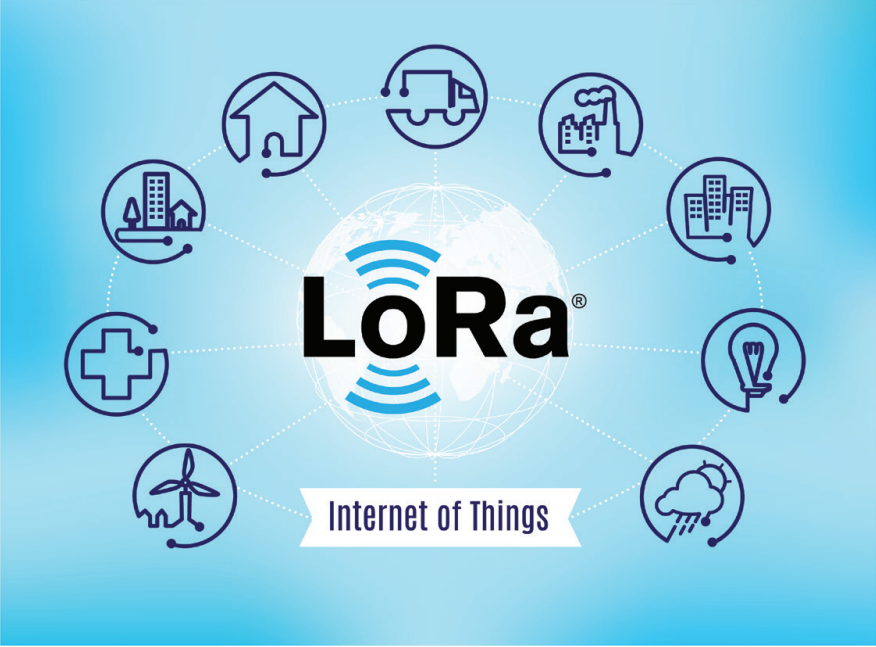
What is LoRaWAN™?
LoRaWAN™ defines the communication protocol and system architecture of the network, while the LoRa® physical layer implements long-distance communication links. This protocol and network architecture have the greatest impact on determining the battery life of nodes, network capacity, quality of service, security, and the diversity of applications served by the network.
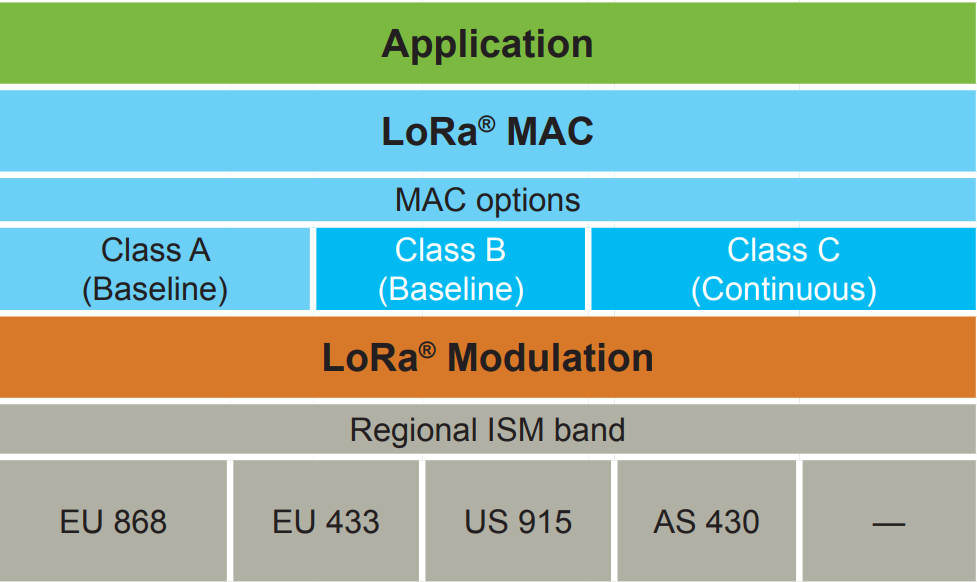
Network Architecture
Many existing deployed networks use a mesh network architecture. In a mesh network, individual end nodes forward information from other nodes to extend the communication range and coverage area. While this can increase communication range, it also adds complexity to the network, reduces network capacity, and shortens battery life as nodes must receive and forward information from other nodes that may not be relevant to them. When long-distance connections can be achieved, a long-range star architecture is most beneficial for extending battery life.

In a LoRaWAN™ network, nodes are not associated with specific gateways. Instead, the data transmitted by a node is typically received by multiple gateways. Each gateway forwards the data packets received from end nodes to a cloud-based network server via some backhaul link (which can be cellular, Ethernet, satellite, or Wi-Fi). Intelligent processing and complex operations are handled by the network server, which manages the network, filters duplicate received packets, performs security checks, arranges the sending of acknowledgment messages through the optimal gateway, and executes adaptive data rate adjustments. If a node is mobile, there is no need to switch between different gateways, which is a key feature for enabling asset tracking applications, a major target application area for IoT.
Battery Life
Nodes in a LoRaWAN™ network are asynchronous and communicate when they have data ready to send, which can be event-driven or scheduled. This type of protocol is often referred to as the Aloha method. In mesh networks or synchronous networks like cellular networks, nodes often need to be “woken up” to synchronize with the network and check for messages. This synchronization operation consumes a lot of energy and is a primary factor leading to reduced battery life. In a recent study and comparison conducted by the Global System for Mobile Communications Association (GSMA) on various low-power wide-area network (LPWAN) technologies, LoRaWAN™ demonstrated a 3 to 5 times advantage in battery life compared to all other technology solutions.
Network Capacity
To make long-range star networks feasible, gateways must have extremely high capacity, meaning they can receive messages from a large number of nodes. LoRaWAN™ networks achieve high network capacity by using adaptive data rates and employing multi-channel, multi-modem transceivers in gateways, allowing them to receive messages simultaneously on multiple channels. Key factors affecting network capacity include the number of concurrent channels, data rate (air transmission time), payload length, and the transmission frequency of nodes. Since LoRa® is based on spread spectrum modulation technology, signals are actually orthogonal when using different spreading factors. As the spreading factor changes, the effective data rate also changes. Gateways utilize this feature to receive multiple different data rates simultaneously on the same channel. If a node has a good connection to the gateway and is close, there is no need to always use the lowest data rate, thus avoiding unnecessarily long occupation of the available spectrum. By increasing the data rate, air transmission time can be shortened, creating more transmission space for other nodes. Adaptive data rates can also optimize the battery life of nodes. For adaptive data rates to work, symmetric uplink and downlink must be achieved, and sufficient downlink capacity must be available. These features give LoRaWAN™ networks extremely high capacity and scalability. During network deployment, minimal infrastructure can be used, and when capacity needs to be increased, more gateways can be added, data rates can be increased, and interference from other gateways can be reduced, thereby increasing network capacity by 6-8 times. Other low-power wide-area network alternatives, due to technical trade-offs, either limit downlink capacity or result in asymmetric downlink coverage compared to uplink coverage, thus lacking the scalability of LoRaWAN™.
Device Classes – Not All Nodes Are the Same
End devices serve different application scenarios and have different requirements. To optimize various end device application profiles, LoRaWAN™ adopts different device classes. These device classes balance the trade-off between downlink communication latency and battery life. In control or actuator-type applications, downlink communication latency is an important factor.

-
Class A Battery-Powered Sensors
- Highest energy efficiency
- Must be supported by all devices
- Downlink communication only occurs after the sensor sends data
-
Class B Battery-Powered Actuators
- High energy efficiency with controllable downlink communication latency
- Communication time slots synchronized with beacons
-
Class C Mains-Powered Actuators
- Devices that can remain in listening mode continuously
- No latency in downlink communication
Class A (Basic Class): The terminal opens only two short reception windows after each uplink transmission, with the lowest power consumption but the highest downlink latency (suitable for low-interaction scenarios like sensors)
Class B (Enhanced Class): Extends the reception window through periodic synchronization time slots, significantly reducing downlink latency but requiring additional energy to support time synchronization
Class C (Continuous Reception Class): Almost always opens the reception window, achieving millisecond-level downlink response, suitable for scenarios requiring real-time control, but with shorter battery life
Bidirectional Terminal Devices (Class A)
Class A terminal devices support bidirectional communication, meaning each terminal device opens two short downlink reception windows immediately after performing an uplink transmission. The transmission time slots arranged by the terminal device are determined based on its communication needs, with slight variations based on random timing (using a similar Aloha protocol). For applications that only require downlink communication shortly after the terminal device completes its uplink transmission, Class A operational mode terminal devices have the lowest system power consumption. Any downlink communication initiated by the server at other times must wait until the next scheduled uplink transmission of the terminal device.
Bidirectional Terminal Devices with Scheduled Reception Slots (Class B)
In addition to having the random reception windows of Class A devices, Class B devices also open additional reception windows at scheduled times. To open the reception window at scheduled times, the terminal device receives a time synchronization beacon from the gateway. This way, the server knows when the terminal device is in listening mode.
Bidirectional Terminal Devices with Maximum Reception Slots (Class C)
Class C terminal devices almost always have their reception windows open, only closing when transmitting.
Security
Incorporating security mechanisms is extremely important for any low-power wide-area network (LPWAN). LoRaWAN™ employs a two-layer security mechanism: one layer for network security and another for application security. The network security layer ensures the authenticity of nodes in the network, while the application layer security ensures that network operators cannot access end-user application data. It uses Advanced Encryption Standard (AES) encryption technology and utilizes IEEE EUI64 identifiers for key exchange.
Every technology choice requires trade-offs, but the features of LoRaWAN™ in network architecture, device classes, security, capacity scalability, and mobility optimization can meet a wide variety of potential IoT application needs.
Overview of LoRaWAN™ Regional Situations
Due to differences in spectrum allocation and regulatory requirements in different regions, the LoRaWAN™ specifications will have slight variations across regions. The LoRaWAN™ specifications for Europe and North America have been established, while those for other regions are still being developed by technical committees. For companies developing solutions for the Asian market, joining the LoRa® Alliance as a contributing member and participating in the work of the technical committee can provide significant advantages.

LoRaWAN™ in Europe
LoRaWAN™ defines 10 channels, of which 8 are multi-data rate channels, with data rates ranging from 250 bits/second (bps) to 5.5 kilobits/second (kbps); there is one single high data rate LoRa® channel with a data rate of 11 kilobits/second; and one single Frequency Shift Keying (FSK) channel with a data rate of 50 kilobits/second. The maximum allowed output power specified by the European Telecommunications Standards Institute (ETSI) is +14 dBm, although the maximum output power allowed in the G3 band is +27 dBm. ETSI imposes restrictions on duty cycle but does not limit maximum transmission time and channel dwell time.
LoRaWAN™ in North America
The Industrial, Scientific and Medical (ISM) band in North America is 902-928 MHz. LoRaWAN™ defines 64 uplink channels at 125 kHz, with frequencies ranging from 902.3 MHz to 914.9 MHz, with a channel spacing of 200 kHz. Additionally, there are 8 uplink channels at 500 kHz, with frequencies ranging from 903 MHz to 914.9 MHz, with a channel spacing of 1.6 MHz. There are 8 downlink channels with a bandwidth of 500 kHz, with frequencies ranging from 923.3 MHz to 927.5 MHz. In the 902-928 MHz band in North America, the maximum output power is +30 dBm, but +20 dBm is sufficient for most devices. The Federal Communications Commission (FCC) has no restrictions on duty cycle, but the maximum dwell time per channel is 400 milliseconds.

North American LoRaWAN™ Hybrid Mode
Most people are familiar with the FCC’s frequency hopping requirements, which require uniform use of more than 50 channels in the Industrial, Scientific and Medical (ISM) band. LoRaWAN™ defines more than 50 channels to fully utilize the available spectrum and achieve maximum output power.
LoRa® modulation belongs to digital modulation technology, so in hybrid operation mode, it does not need to fully comply with all frequency hopping requirements set by the FCC. In hybrid mode, the maximum output power limit is +21 dBm, and only a subset of 8 channels from the 64 uplink channels is used.
According to the regulations from the FCC: “Hybrid systems use both digital modulation and frequency hopping technology simultaneously on the same carrier. As specified in Section 15.247(f), when the frequency hopping function is turned off, the power density standard for hybrid systems within any 3 kHz band must comply with the 8 dBm requirement. When the frequency hopping function is turned on, the maximum dwell time for each transmission on each channel must be 0.4 seconds. This type of hybrid system does not need to comply with the usual 500 kHz minimum bandwidth requirement associated with direct-sequence spread spectrum (DSSS) transmissions; nor does this type of hybrid system have a minimum frequency hopping channel number requirement.
Comparing Low-Power Wide-Area Network (LPWAN) Technology Solutions
The Internet of Things is a very active field, and people are comparing different LPWAN solutions not only from a technical perspective but also from a business model perspective. Currently, LPWAN networks are being gradually deployed, as there are strong business reasons to support immediate deployment, and the funding required to deploy networks in unlicensed frequency bands is even less than that needed for a 3G software upgrade. When comparing different LPWAN technologies, the following questions need to be answered:
- Application Flexibility: Can it flexibly adapt to a variety of application scenarios?
- Communication Protocol Security: Is the communication protocol secure and reliable?
- Technical Features: How are the coverage, capacity, bidirectional communication capability, and anti-interference capabilities?
- Cost: What are the network deployment costs, bill of materials (BOM) costs for end nodes, and battery costs (the largest portion of the BOM)?
- Solution Provider Ecosystem: Is there a rich ecosystem of solution providers to support flexible business models?
- End Product Availability: Are there ready-made end products to ensure that network deployment can achieve a return on investment?
- Ecosystem Strength: Is the ecosystem strong enough to ensure the quality and long-term stability of the solution?
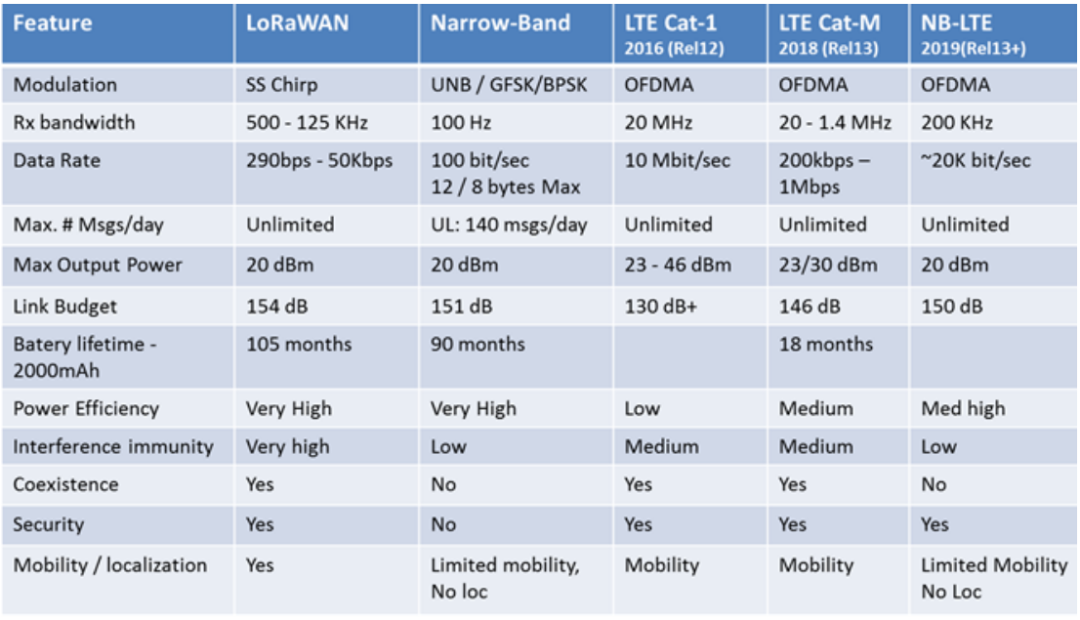
Cost of Low-Power Wide-Area Networks (LPWAN) Compared to Traditional Systems
Compared to existing systems, LoRaWAN™ can significantly save costs in deployment and required infrastructure. The following analysis was completed by Talkpool, a company with extensive experience in deploying solutions based on Wireless M-Bus (WMBus) and LoRa®.
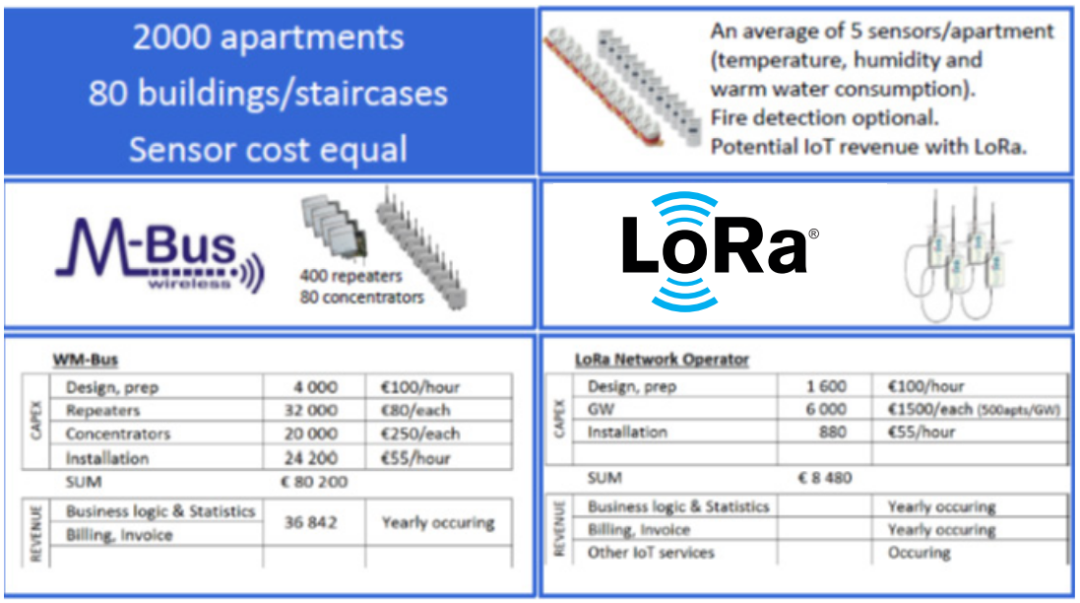
This white paper is sponsored by members of the LoRa® Alliance, particularly supported by the platinum sponsors of the all-member meeting in November 2015.
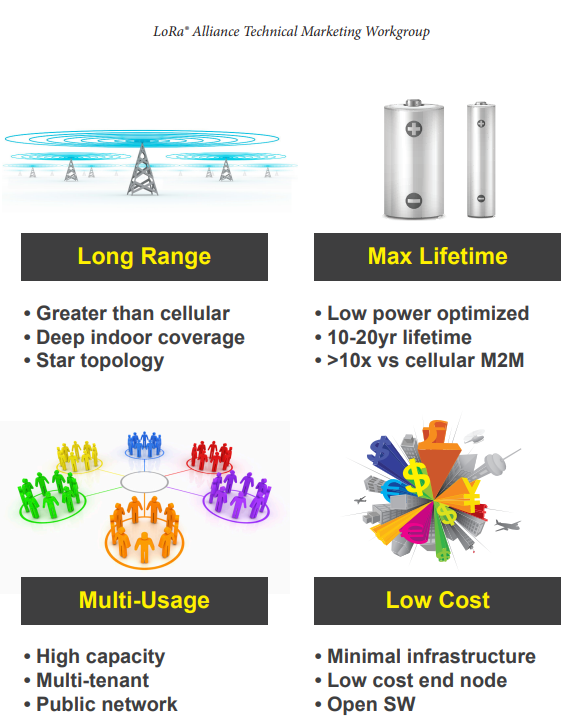
The LoRa® name and related logos are trademarks of Semtech Corporation or its subsidiaries. Semtech, the Semtech logo, and LoRa® are registered trademarks of Semtech Corporation. LoRaWAN™ is a trademark of Semtech Corporation. This white paper was designed by Semtech Corporation.
Source
https://lora-alliance.org/wp-content/uploads/2020/11/what-is-lorawan.pdf